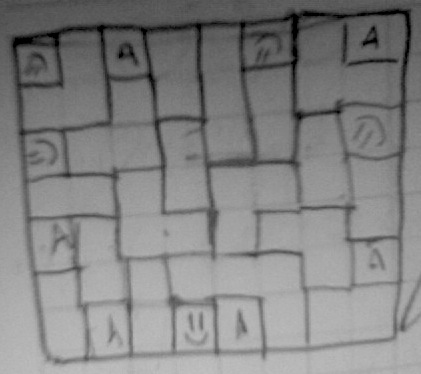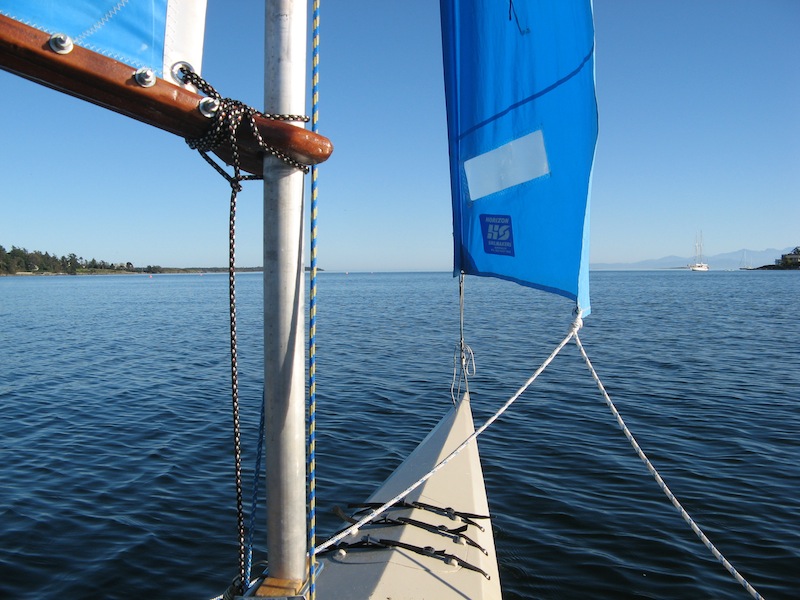My tatami work at Moka House was briefly interrupted by a very enjoyable coffee with my friend Gwen Temmel today, during which she suggested that tatami tilings looked a little like the game Dots and Boxes. A light went on inside me and I said,
LET’S PLAY DOTS AND BOXES WITH THE TATAMI CONDITION,
which just about as much inward enthusiasm. The result was this:

If it is not obvious already, the game is played just as Dots and Boxes, but you may not create a four-valent site. In other words, no pluses may be created. If a player makes a box they must go again, no player may pass, the game ends when no legal move exists.
Playing this game is more fun, in my opinion than the original Dots and Boxes, and there is a mathematical curiosity that comes up. Dots and Boxes ends when all bonds (edges) have been added, whereas this one has many different endings, each of them a maximal bond animal of a (typically) rectangular integer grid. How many of these are there?
Notice that some tatami tilings are not maximal in this sense. When a bidimer (formerly hamburger) has a long edge on the boundary of the grid, one of its dimers can be split into monomers. I think this is the only such case, however.

Have you played Tatami Dots and Boxes? Tell me about it in the comments!
What better way to start this tatami blog than with a bit of tatami art! Here is a calligraphic illumination I created for the letter F.

This is an extension of Conway’s Game of Life in which there is more than one player (colour) and a fifth rule. To win the game (or be winning) you must have more of your own cells on the board than your opponent does.
From Wikipedia, here are the rules to the original Game of Life
- Any live cell with fewer than two live neighbours dies, as if caused by under-population.
- Any live cell with more than three live neighbours dies, as if by overcrowding.
- Any live cell with two or three live neighbours lives on to the next generation.
- Any dead cell with exactly three live neighbours becomes a live cell, as if by reproduction.
Now we introduce colours and an extra rule. Two two cells are friendly if they are the same colour:
- Any live cell with fewer than two live friendly neighbours dies, as if by loneliness.
- Any live cell with more than three live friendly neighbours dies, as if by overcrowding.
- Any live cell with two or three friendly neighbours lives, unchanged, to the next generation (unless it dies at number 4).
- Any live cell with strictly more enemy than friendly neighbours, dies.
- Any dead cell with exactly three mutually friendly neighbours and no other live neighbours comes to life.
As you can see, when only the cells of one player are involved, these are the rules of the Game of Life. When there are enemies, majority wins!
{swf;http://alejandroerickson.com/joomla/images/swf/game_of_life.swf}
Starting with a thesaurus, here is a list of words synonymous with “walk”.
stroll, saunter, amble, trudge, plod, dawdle, hike, tramp, tromp, slog, stomp, trek, march, stride, sashay, glide, troop, patrol, wander, ramble, tread, prowl, promenade, roam, traipse, stretch one’s legs, mosey, hoof it, perambulate.
Wanting a more general list, we brainstormed for other words. Some may be repeated and some may be made up.
sprint run jog stampede stomp waltz saunter swoop scuttle walk scamper to wheel strut glide creep crawl skip skate gallop trot hobble roll sneak patter stride leap hop bounce scurry skidaddle slither slide swim waddle scanter
I have three challenges for you.
- At a party, play an improv game where you pick one of these words out of a hat and act out that type of … ambulation
- Make a video of yourself ambulating in one of the above ways, post it to YouTube and put the link in the comments here.
- Contribute to the list!

FINALLY!
Not much to say about this moment except that I’ve been dreaming about it for a year now and it’s finally happened.
I’m adding some text to make this more searchable, but the fun is my giddiness in the video. I bought the Pygmy Coho kayak with the pontoons (ammas?) in Campbell River, BC, one day because I found it while I was in Victoria looking for a desk on Craigslist. I took $1500 out in cash and jumped in a rental car (which they upgraded to an SUV for free, thank GOD, because I have no clue how I would have put all that stuff on top of a Neon) and drove 3 hours, just to see if I wanted the thing. I handed the guy $1300 and took it home.
After using it as a kayak for a while, I sailed the rig it came with and decided it was mediocre at best. I wanted a REAL sailing rig, with a jib, cable stays and a BEAUTIFUL WOMAN (You noticed her conspicuous absence in the video). The necessary condition for BW is to have places for both of us to sit, so rather than wasting my efforts looking for BW, I installed benches. I expect BW to appear shortly :D.
Long story short, I got a free sail, boarded with a shipwright for a few days, learnt to sail, learnt about rigs, learnt about “boat dollars” and learnt about the sailing bug. Now I’m out of boat dollars, but I’ve got the bug and, fortunately, a sailboat (if you can call it that) as well!
If you want to know more about the boat, see this post about how I rigged it. Incidentally, if you get into sailing, you’ll run into all kinds of people with extra gear to trade, sell or give away. Everybody is friendly because they are all doing what they want to be doing :).